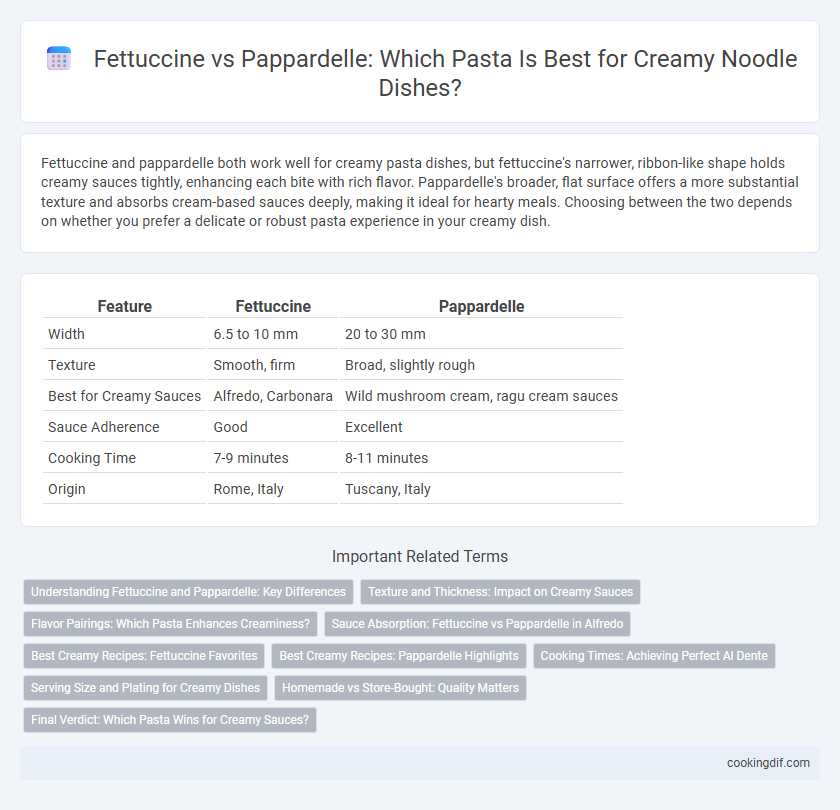Fettuccine and pappardelle both work well for creamy pasta dishes, but fettuccine's narrower, ribbon-like shape holds creamy sauces tightly, enhancing each bite with rich flavor. Pappardelle's broader, flat surface offers a more substantial texture and absorbs cream-based sauces deeply, making it ideal for hearty meals. Choosing between the two depends on whether you prefer a delicate or robust pasta experience in your creamy dish.
Table of Comparison
| Feature | Fettuccine | Pappardelle |
|---|---|---|
| Width | 6.5 to 10 mm | 20 to 30 mm |
| Texture | Smooth, firm | Broad, slightly rough |
| Best for Creamy Sauces | Alfredo, Carbonara | Wild mushroom cream, ragu cream sauces |
| Sauce Adherence | Good | Excellent |
| Cooking Time | 7-9 minutes | 8-11 minutes |
| Origin | Rome, Italy | Tuscany, Italy |
Understanding Fettuccine and Pappardelle: Key Differences
Fettuccine and pappardelle differ primarily in width, with fettuccine typically around 6.5 to 10 millimeters wide, while pappardelle measures 25 to 30 millimeters, affecting their texture and sauce absorption in creamy pasta dishes. Fettuccine's narrower shape provides a balanced, lighter coating of rich cream sauces like Alfredo, creating a smooth mouthfeel. Pappardelle's broad, flat ribbons are ideal for thicker, heavier cream sauces, offering a robust bite and enhanced sauce retention that complements hearty ingredients.
Texture and Thickness: Impact on Creamy Sauces
Fettuccine's thinner, flat ribbons provide a silky texture that allows creamy sauces to cling smoothly, enhancing each bite with balanced coverage. Pappardelle's broader, thicker strands offer a heartier, more substantial mouthfeel that holds rich, thick sauces well, making it ideal for robust creamy pasta dishes. The choice between fettuccine and pappardelle significantly influences the sauce-to-noodle ratio, impacting overall texture and flavor depth in creamy pasta recipes.
Flavor Pairings: Which Pasta Enhances Creaminess?
Fettuccine's slightly narrower ribbons hold creamy sauces like Alfredo or carbonara effectively, allowing rich flavors such as parmesan, garlic, and butter to coat every strand. Pappardelle, with its wide, flat surface, provides a hearty texture that absorbs thicker cream-based sauces infused with robust ingredients like mushrooms, truffle, or sausage. For enhancing creaminess, fettuccine offers a smoother mouthfeel, while pappardelle delivers a more substantial bite that emphasizes bold, savory flavor pairings.
Sauce Absorption: Fettuccine vs Pappardelle in Alfredo
Fettuccine's narrower, flatter ribbons excel at holding creamy Alfredo sauce, allowing for a balanced coating that enhances each bite. Pappardelle's broader surface offers more sauce grip but can sometimes overwhelm the creamy texture, making the dish feel heavier. Choosing fettuccine ensures optimal sauce absorption and a smoother Alfredo experience, preserving flavor harmony.
Best Creamy Recipes: Fettuccine Favorites
Fettuccine's narrow, flat ribbons excel in clinging to rich, creamy sauces, making it ideal for classic Alfredo and carbonara recipes. Its texture provides the perfect balance, enhancing the sauce's velvety feel without overpowering the dish. For creamy pasta dishes, fettuccine remains a favorite choice over pappardelle, which is better suited to hearty, chunky sauces.
Best Creamy Recipes: Pappardelle Highlights
Pappardelle's wide, flat ribbons excel at capturing rich, creamy sauces, making it the perfect choice for indulgent pasta dishes like creamy mushroom or truffle sauce recipes. Its broader surface area compared to fettuccine allows for enhanced sauce adhesion, delivering a more flavorful bite with every forkful. Recipes featuring pappardelle highlight its ability to balance the richness of cream-based sauces while maintaining a satisfying texture.
Cooking Times: Achieving Perfect Al Dente
Fettuccine typically requires 8 to 10 minutes to reach the ideal al dente texture, providing a firm bite that holds creamy sauces well without becoming mushy. Pappardelle, being wider and thicker, demands a longer cooking time of 10 to 12 minutes to achieve the perfect balance between tenderness and structure. Mastering these precise cooking times ensures that creamy pasta dishes retain their silky texture while complementing the pasta's surface area for optimal sauce adherence.
Serving Size and Plating for Creamy Dishes
Fettuccine's narrower width allows for better sauce adherence and portion control, making it ideal for individual servings of creamy pasta dishes. Pappardelle's broad, ribbon-like shape offers a more rustic presentation and works well for family-style plating where larger portions are desired. Both noodles complement creamy sauces, but fettuccine excels in refined plating, while pappardelle emphasizes generous, visually striking servings.
Homemade vs Store-Bought: Quality Matters
Homemade fettuccine offers a tender texture that absorbs creamy sauces evenly, while store-bought versions may vary in quality and thickness, affecting sauce adherence. Pappardelle's broader ribbons excel in holding rich, creamy sauces, with homemade varieties providing superior freshness and elasticity compared to mass-produced alternatives. Quality homemade noodles, crafted from high-protein flour and fresh eggs, significantly enhance the flavor and creaminess of pasta dishes versus many store-bought options.
Final Verdict: Which Pasta Wins for Creamy Sauces?
Fettuccine's narrow, flat shape holds creamy sauces like Alfredo and Carbonara with exceptional consistency, allowing each strand to be richly coated and enhancing every bite. Pappardelle, while broader and ideal for chunky or meaty sauces, tends to overpower delicate cream-based textures, making it less optimal for smooth, velvety dishes. For creamy pasta recipes, fettuccine remains the preferred choice due to its balanced surface area and ability to cling to luscious, creamy sauces perfectly.
Fettuccine vs Pappardelle for creamy pasta dishes Infographic

 cookingdif.com
cookingdif.com